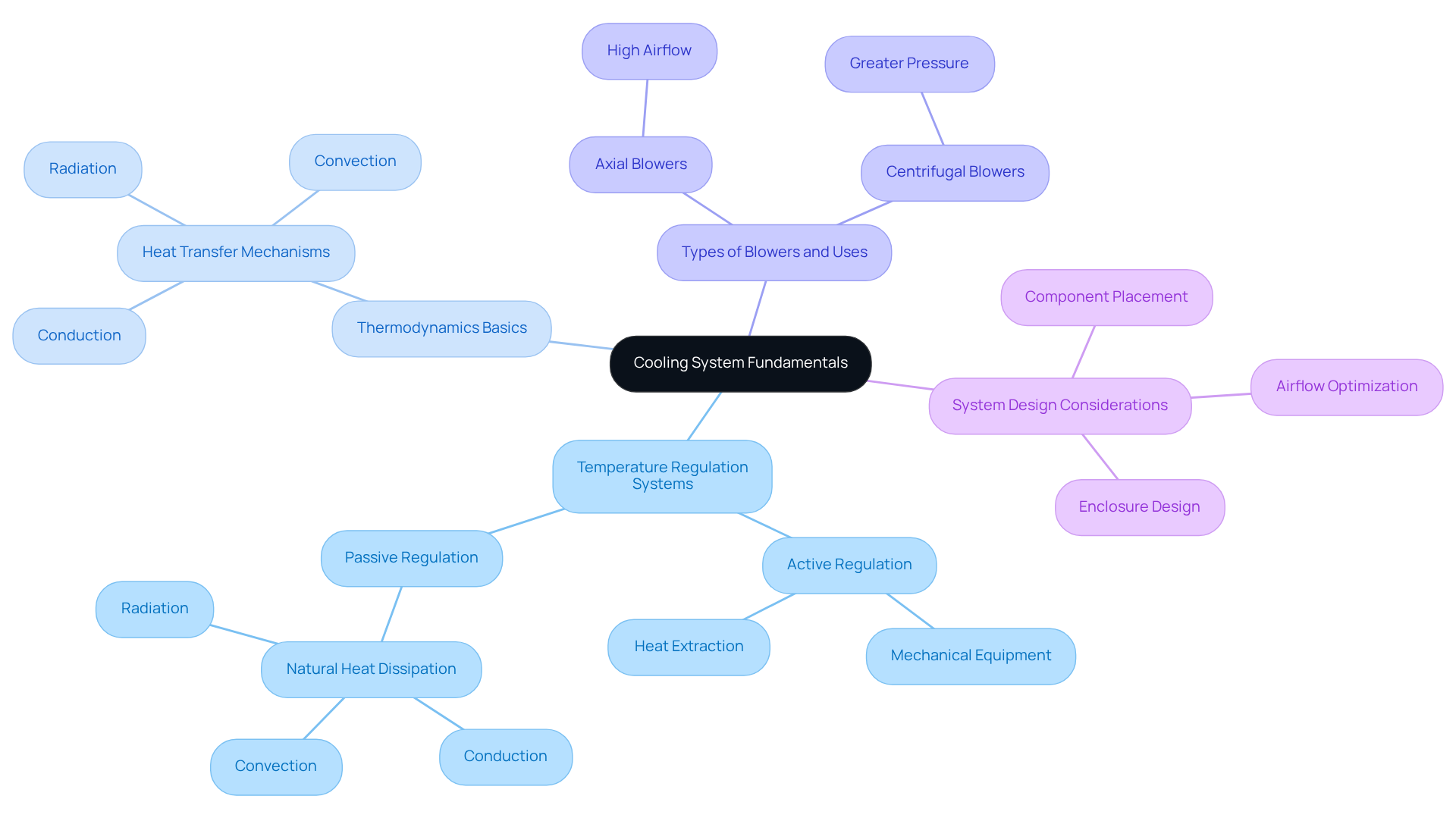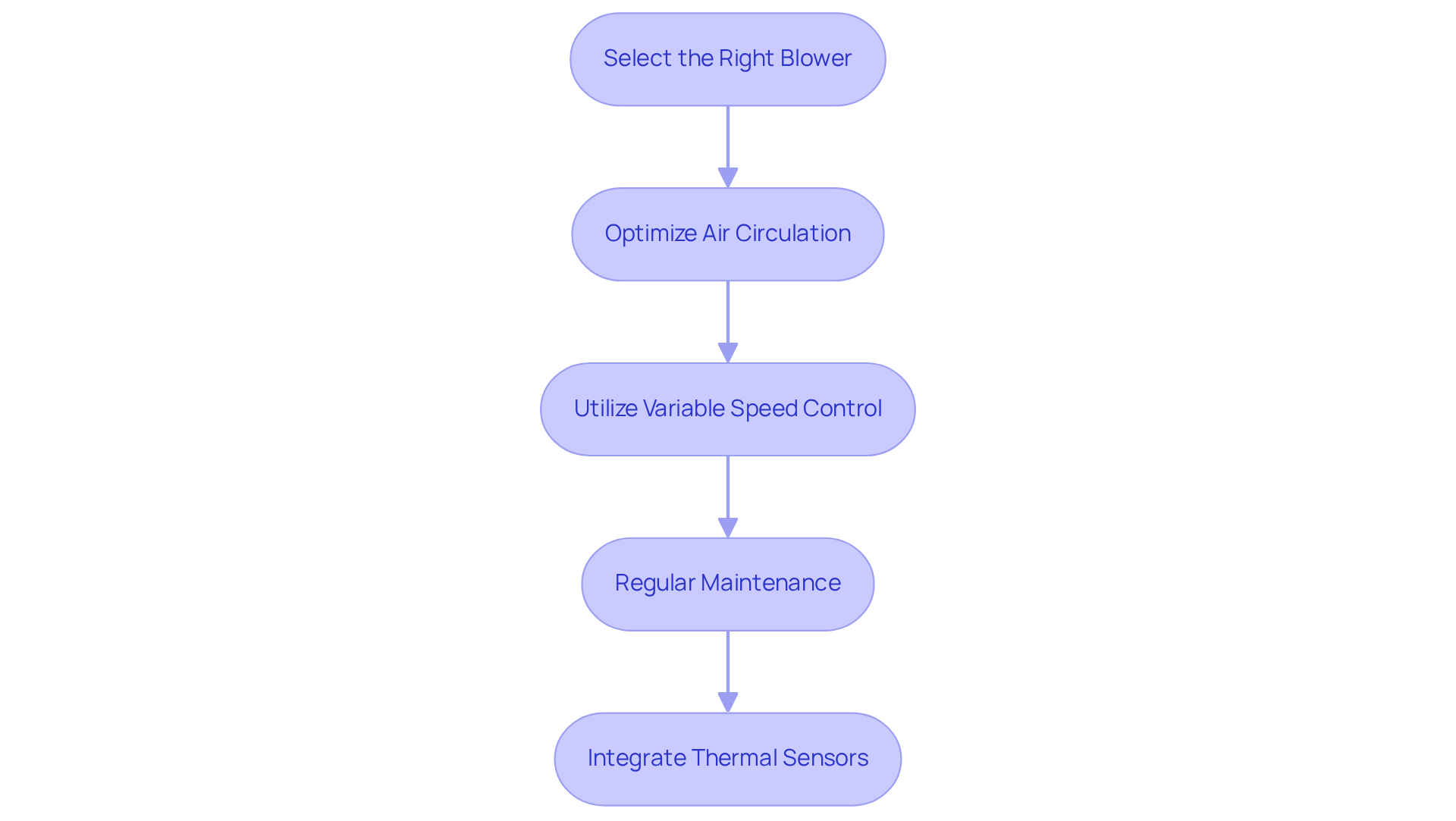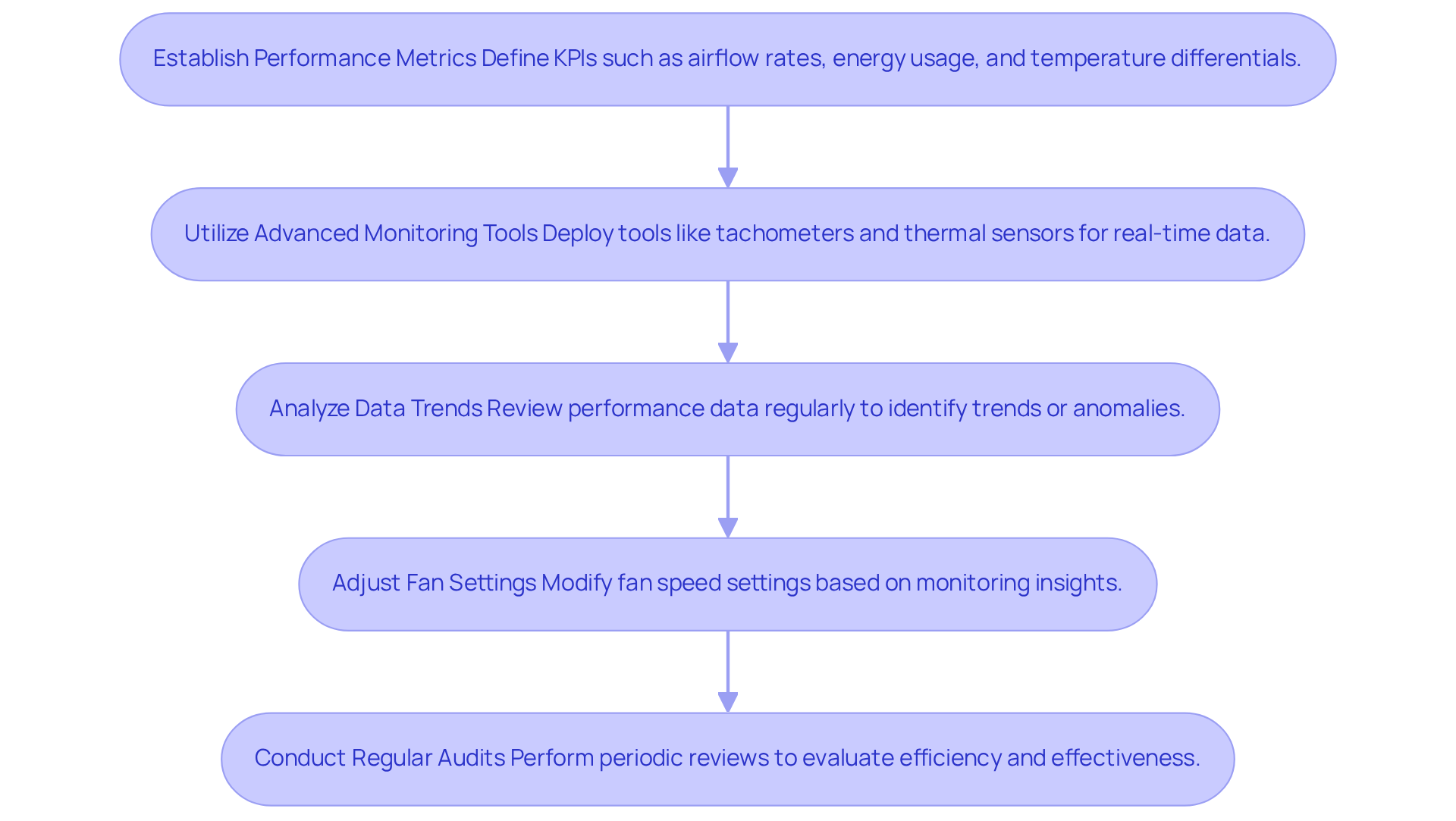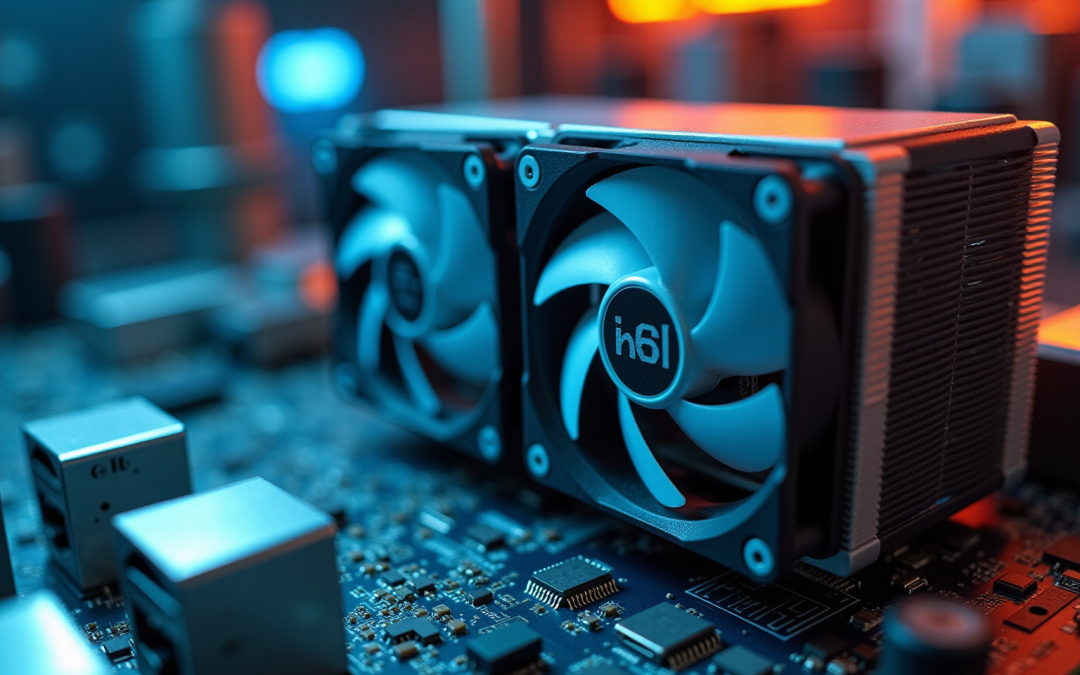Overview
The article outlines essential steps that electronics engineers can undertake to enhance the efficiency of cooling fans within electronic systems. It underscores the necessity of grasping the fundamentals of cooling systems, employing strategies that boost fan performance, and instituting monitoring practices to guarantee optimal operation. These measures collectively contribute to improved functionality and a reduction in operational costs.
Introduction
Understanding the intricacies of cooling systems is essential for electronics engineers aiming to enhance the efficiency of their fans. As technology evolves, optimizing fan performance not only improves device reliability but also contributes to energy conservation.
However, engineers face the challenge of navigating various cooling methods, blower types, and system design considerations that can significantly impact overall efficiency. Therefore, what strategies can engineers employ to ensure their cooling solutions meet the demands of modern electronic applications?
Understand Cooling System Fundamentals
To optimize fan efficiency, engineers must first grasp the fundamental principles of cooling systems, which include:
-
Types of Temperature Regulation Systems: Familiarize yourself with active and passive methods of temperature control. Active temperature regulation utilizes mechanical equipment like blowers and pumps to improve heat extraction, especially essential when surrounding temperatures increase to 40°C. Passive cooling relies on natural heat dissipation through conduction, convection, and radiation. Gagner-Toomey Associates offers a broad product line of DC input Tube Axial fans and Centrifugal Blowers, which are designed with an efficient fan technology optimized for performance and efficiency, making them ideal for various applications in electronics and beyond.
-
Thermodynamics Basics: Understanding heat transfer mechanisms is crucial. Conduction transfers heat through materials, convection involves fluid movement carrying heat away, and radiation allows heat to escape through electromagnetic waves. Mastery of these principles is essential for effective thermal management in electronic systems. Gagner-Toomey’s innovative temperature regulation solutions, including extruded aluminum heatsinks and copper-based heat sinks, enhance thermal management by utilizing an efficient fan to dissipate heat.
-
Types of Blowers and Uses: Various blower types, including axial and centrifugal varieties, fulfill particular refrigeration requirements. Axial units are perfect for high airflow at low pressure, while centrifugal devices produce greater pressure for more confined areas. Gagner-Toomey’s wide variety of efficient fans, ranging from compact options for limited areas to larger models, ensures that engineers can find the appropriate match for their temperature control needs. Each type’s characteristics significantly influence airflow dynamics and temperature control.
-
System Design Considerations: The design of the enclosure and the strategic placement of components are essential for optimizing airflow and thermal efficiency. Engineers should ensure that airflow paths are unobstructed and that components are arranged to facilitate effective heat dissipation. For example, the Complete Thermal Management Framework (CTMF) incorporates both active and passive temperature regulation circuits to control heat across different components, employing Gagner-Toomey’s integrated temperature management solutions like bespoke thermal arrangements that combine fans, heat pipes, and radiators.
By mastering these fundamentals, engineers can precisely evaluate their thermal needs and choose the most appropriate efficient fan technologies for their applications, ultimately enhancing the performance and reliability of electronic devices.

Implement Strategies for Enhanced Fan Efficiency
To enhance fan efficiency in electronic cooling systems, consider the following strategies:
-
Select the Right Blower: Choosing blowers tailored to your application’s specific requirements is essential. Key factors include airflow (measured in CFM), static pressure (in inches of water gauge), and noise levels. Understanding the relationship between airflow and static pressure is crucial, as maximum values for both cannot be achieved simultaneously. As Johann Tang notes, a deeper understanding is necessary to determine how the fan will actually perform in a real-life scenario.
-
Optimize Air Circulation: Position devices strategically to maximize airflow and minimize obstructions. Clear inlet and outlet paths are essential to prevent turbulence and back pressure, which can significantly hinder performance. For instance, ensuring that devices are not positioned too close to heat sources can assist in preserving optimal airflow.
-
Utilize Variable Speed Control: Implementing variable speed drives or PWM (Pulse Width Modulation) controls allows for the adjustment of fan speed according to real-time cooling needs. This not only enhances efficiency but also makes use of an efficient fan that reduces energy consumption during low-load conditions, making it a viable energy-saving option.
-
Regular Maintenance: Scheduling routine maintenance to clean fan blades and housing is critical, as dirt accumulation can drastically reduce efficiency. Routine inspections guarantee that all parts operate properly, avoiding unnecessary energy waste and prolonging the longevity of the devices. A maintenance program can lead to a 30% increase in fan lifespan, demonstrating the importance of upkeep.
-
Integrate Thermal Sensors: Employing thermal sensors to monitor temperature and automatically adjust fan speed is a proactive strategy that ensures fans function only when required. This optimizes energy consumption and improves overall efficiency.
By applying these strategies, engineers can greatly enhance the efficiency of their cooling systems, including the use of an efficient fan, resulting in improved functionality and lower operational costs.

Monitor and Adjust for Optimal Performance
To ensure optimal fan performance, engineers must adopt effective monitoring and adjustment practices:
- Establish Performance Metrics: It is crucial to define key performance indicators (KPIs) such as airflow rates, energy usage, and temperature differentials to effectively assess fan operation.
- Utilize Advanced Monitoring Tools: Deploy advanced mechanisms that provide real-time data on fan speed, airflow, and temperature. Instruments such as tachometers, thermal sensors, and automated Building Management Systems (BMS) are essential for gaining insights into system functionality, allowing for proactive management.
- Analyze Data Trends: Regularly reviewing performance data is vital for identifying trends or anomalies. This analysis is essential for detecting potential issues early, allowing for timely interventions that can prevent costly downtime. For instance, efficient fans can reduce power usage by up to 70% compared to traditional AC fans, underscoring the importance of effective monitoring.
- Adjust Fan Settings: Based on insights gained from monitoring data, it is important to adjust fan speed settings or operational schedules to better align with actual temperature demands. This may involve recalibrating controls or modifying fan curves to enhance efficiency.
- Conduct Regular Audits: Periodic reviews of the entire refrigeration setup are necessary to evaluate efficiency and effectiveness. This involves checking for airflow obstructions, verifying sensor accuracy, and ensuring that all components function as intended. Case studies, such as those on Hot Spot Identification, illustrate how monitoring tools can prevent equipment failure and unplanned downtime.
By implementing these monitoring and adjustment practices, engineers can sustain high levels of efficient fan operation, ensuring that cooling systems operate at peak performance. The shift towards energy-efficient technologies is not merely a trend; it is a necessity for sustainable development in the electronics industry.

Conclusion
Optimizing the efficiency of fans in electronic cooling systems is paramount for enhancing performance and reliability. Understanding the fundamentals of cooling systems enables engineers to make informed decisions regarding the types of fans and blowers that best suit their applications. This foundational knowledge not only facilitates the implementation of effective strategies that significantly improve fan efficiency but also leads to better thermal management and energy savings.
Key strategies for enhancing fan efficiency encompass:
- Selecting the appropriate blower based on specific requirements
- Optimizing air circulation to minimize turbulence
- Incorporating variable speed controls for real-time adjustments
Additionally, regular maintenance and the integration of thermal sensors are vital to ensuring that cooling systems operate at peak performance. These practices not only prolong the lifespan of fans but also contribute to substantial energy savings.
In the rapidly evolving landscape of electronics, the emphasis on energy-efficient technologies has never been more critical. Engineers are urged to adopt these best practices and leverage advanced monitoring tools to maintain optimal fan performance. By doing so, they can enhance the functionality of their cooling systems while contributing to a more sustainable future in electronic design and manufacturing.
Frequently Asked Questions
What are the main types of temperature regulation systems?
The main types of temperature regulation systems are active and passive methods. Active temperature regulation uses mechanical equipment like blowers and pumps for heat extraction, while passive cooling relies on natural heat dissipation through conduction, convection, and radiation.
Why is understanding thermodynamics important for cooling systems?
Understanding thermodynamics is crucial because it involves the mechanisms of heat transfer, including conduction, convection, and radiation. Mastery of these principles is essential for effective thermal management in electronic systems.
What types of blowers are mentioned, and what are their uses?
The article mentions axial and centrifugal blowers. Axial blowers are ideal for high airflow at low pressure, while centrifugal blowers produce greater pressure suitable for confined spaces.
How does system design impact thermal efficiency?
System design impacts thermal efficiency by ensuring that the enclosure is optimized for airflow and that components are strategically placed to facilitate effective heat dissipation. Unobstructed airflow paths are essential for maintaining thermal performance.
What is the Complete Thermal Management Framework (CTMF)?
The Complete Thermal Management Framework (CTMF) incorporates both active and passive temperature regulation circuits to control heat across different components, utilizing integrated temperature management solutions that combine fans, heat pipes, and radiators.
How can engineers improve the performance and reliability of electronic devices?
Engineers can improve the performance and reliability of electronic devices by mastering cooling system fundamentals, accurately evaluating thermal needs, and selecting the most appropriate efficient fan technologies for their applications.

